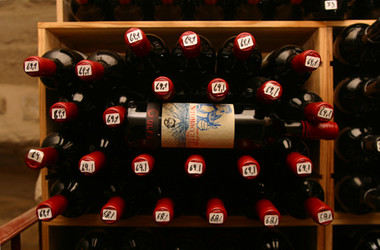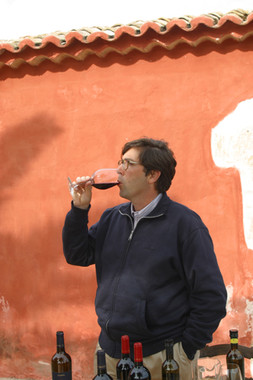From grape to glass: Sicilian wine turns heads
March 25, 2007 - Agence France Presse

CHIARAMONTE GULFI, Italy (AFP)
Becoming a world-known grape variety such as Shiraz, Cabernet Sauvignon or Chardonnay is no mean task, yet Sicily’s once little-known native red grape, Nero d’Avola, seems on the cusp of a breakthrough.
Up until the 1980s, its rich velvety reds were used primarily to strengthen lighter wines in northern Italy and France, and plantings were on the decline.
Now a good bottle will open up aromas of cherry, licorice or even tobacco, though a not-so-good one can still be like a wall of alcohol that floods the nose.
In the last three decades, the road to solo success for Sicily’s signature grape has involved the use of technology as well as a jolt from new producers.
“In the last two to three years, the wine market has changed,” says Massimo Ruffino, export manager for the Gulfi winery in Chiaramonte Gulfi, as he drives from one parcel to the next, passing through rolling hillsides of almond trees, grape vines and pasture.
While Gulfi has only been selling wines for around a decade, the grape has underscored the company’s success. Winery founder Vito Catania went from being a penniless car salesman to dabbling with a wine that has caught on both here and abroad.
Currently, Gulfi is busy moving from producing wine in what amounts to an industrial-sized aluminum shed to a multimillion-euro winery that would impress even the likes of California’s Robert Mondavi.
And everywhere in this southern Sicilian valley, the grape’s momentum seems almost palpable.
“What we’re seeing here is like the hype that surrounded Tuscan wines not so long ago,” said Philippe Martinet, a Frenchman who sells wine in Malta and now wants to add a few Sicilian wines to his offerings.
 Alessio Planeta drinking from a glass, at Planeta winery near the Sicilian town of Noto. Becoming a world-known grape variety such as Shiraz, Cabernet Sauvignon or Chardonnay is no mean task, yet Sicily’s once little-known native red grape, Nero d’Avola, seems on the cusp of a breakthrough (Photo AFP/Joe Ray)
Alessio Planeta drinking from a glass, at Planeta winery near the Sicilian town of Noto. Becoming a world-known grape variety such as Shiraz, Cabernet Sauvignon or Chardonnay is no mean task, yet Sicily’s once little-known native red grape, Nero d’Avola, seems on the cusp of a breakthrough (Photo AFP/Joe Ray)
“People are more curious about native varieties, not just international ones such as Chardonnay and Syrah,” said Ruffino, who also teaches wine courses in Korea.
But bringing Nero d’Avola to the fore caused a brush between technology and terroir, and for a while, terroir took a back seat to progress.
“New international techniques gave us a general increase in quality, but we lost what was typical about the grape,” said Gulfi oenologist Salvo Foti. “Technology has to be used at the service of terroir. Not the opposite.”
Many vineyards across Sicily have since taken that step. For some, such as Gulfi, this has meant going partially organic, while others have returned to growing in the “alberello” style—the historic method of growing vines like small trees.
“It can take 25 to 30 years for a Sicilian vineyard to be at its best,” said Foti. “It’s hard work and expense and investment, which hopefully pays off.”
Much of the momentum behind the Sicilian wine’s success came from Sicily’s Planeta winery, with even the company’s competitors acknowledging their debt of gratitude.
Diego Planeta began experimenting with making wines in Sicily in 1985 and started to sell them 10 years later.
After making a name promoting international varieties like Chardonnay and Merlot, the winery fine-tuned production of Nero d’Avola, which eventually became its star grape.
“Our name was sort of a guarantee to help introduce Nero d’Avola,” said Planeta’s daughter Francesca, who heads up sales and marketing.
At the beginning, Planeta’s top-of-the-line bottle, Santa Cecilia, was a blend of Nero d’Avola and Syrah (also known as Shiraz). Later, for the wine of the same name, the winery dropped the Syrah and blended Nero d’Avola from two different Sicilian regions.
Currently the wine is made entirely of Nero d’Avola hailing from the grape’s historic home near the city of Noto in southeastern Sicily.
“In the beginning, we were not talking about a variety, but about a brand,” said Francesca, referring to Santa Cecilia. “But slowly, people wanted to know more about the variety. Now, more producers are able to sell on the name of Nero alone.”
Cousin Alessio, working at the company’s outpost near the southeastern town of Noto, disagreed. “Using the name Nero d’Avola alone could be dangerous,” he said. “You start to find different styles, prices and qualities.”
To him, the D.O.C., or name control Eloro which tends to have a large percentage of Nero d’Avola grapes, has been watered down to the point that he would like to see a new name control with more rigorous standards to highlight what he calls “Sicily’s star variety”.
Name control or not, back at the Gulfi winery, it seems Sicilian producers’ efforts with the grape are paying off. Malta wine seller Philippe Martinet, who seemed curious but a bit dubious about Nero d’Avola’s potential at the beginning of a tasting, quickly changed his tune once the wine was poured.
“Oh la la! There’s something real and profound here,” he said. “These are exciting wines.”
This article also ran with: Yahoo News.